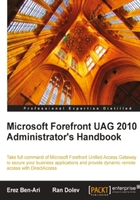
In this chapter, we will discuss UAG's building blocks— trunks and applications. We will review the various types of each, what they are used for, and how to create them. We will not cover specific application publishing as this will be described in depth in Chapter 4, but we will introduce some of the concepts that make the whole thing tick.
Just as we like to organize everything in life into containers, UAG also does the same. As a user of Microsoft products, you are probably used to files or programs that are grouped together within folders and which are stored on hard drives (or hard drive partitions). With UAG, there's one little difference, the primary organizational units are called "trunks", and in those we create (or "publish") applications, and we can also group them in folders too. The reason for this difference in naming goes back into the distant past, but it doesn't really matter.
The first step when starting to publish applications with UAG is to create a trunk, and then, add applications to it, as needed. A UAG server can contain multiple trunks, depending on how many IP addresses are assigned to its external interface. Some organizations need only a single application on a single trunk, while others publish multiple trunks, with dozens of applications on each of them. If many applications need to be published on a single trunk, the administrator can also organize them into folders, which can make it easier for users to find.

An "application" for UAG is a collection of settings and rules that determine how UAG publishes a certain internal website or application. These settings include, among others, the name or IP address of the internal server that will be published, what files and folders are accessible by the end users, and which users have access to what. We will discuss the various properties and rules specific to application publishing in Chapter 4.
At any point, an administrator can add IP addresses to the external NIC of the UAG server, add public DNS mappings to these addresses, and add more trunks. This is also an alternative way to organize the various applications—some organizations publish several Portals with different addresses, and provide the public URLs to groups of employees based on their needs. That is done, of course, in addition to defining the authorization on the trunks themselves.
